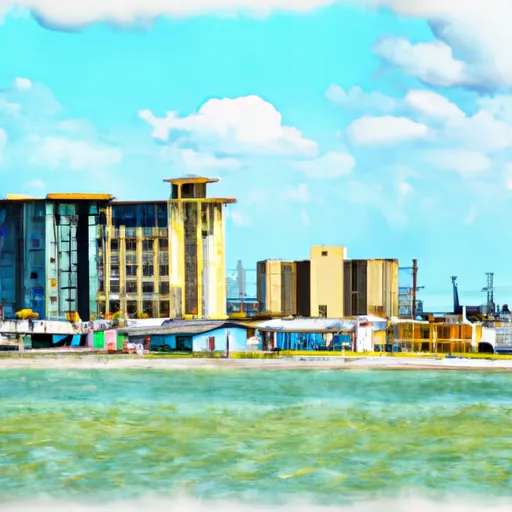-
 Snoflo Premium
Snoflo Premium
Get unlimited access to all our content
With no Ad interruptions! - Start Your Free Trial Login with existing account
Crystal-Beach
Eden Index
Climate
7.6
•
Recreation
3.7
•
Community
0.5
•
Safeguard
4.5/10

Crystal Beach, Texas is a coastal community located on the Bolivar Peninsula. The climate in Crystal Beach is generally warm and humid, with hot summers and mild winters. The area is prone to heavy rain and occasional hurricanes. As a coastal community, the hydrology constituents of Crystal Beach include the Gulf of Mexico and the Intracoastal Waterway. These bodies of water provide opportunities for fishing, boating, and other water-based activities. The area is also known for its sandy beaches and dunes, making it a popular spot for beachcombing, sunbathing, and bird watching. Additionally, there are numerous parks and nature preserves in the area, such as the Anahuac National Wildlife Refuge, that offer hiking, camping, and wildlife viewing opportunities.
What is the Eden Index?
The Snoflo Eden Index serves as a comprehensive rating system for regions, evaluating their desirability through a holistic assessment of climate health, outdoor recreation opportunities, and natural disaster risk, acknowledging the profound impact of these factors on livability and well-being.
Climate Health Indicator (CHI): 7.6
Crystal-Beach receives approximately
1172mm of rain per year,
with humidity levels near 83%
and air temperatures averaging around
21°C.
Crystal-Beach has a plant hardyness factor of
9, meaning
plants and agriculture in this region tend to thrive here all year round.
By considering the ideal temperature range, reliable water supplies, clean air, and stable seasonal rain or snowpacks, the Climate Health Indicator (CHI) underscores the significance of a healthy climate as the foundation for quality living.
A healthy climate is paramount for ensuring a high quality of life and livability in a region, fostering both physical well-being and environmental harmony. This can be characterized by ideal temperatures, reliable access to water supplies, clean air, and consistent seasonal rain or snowpacks.
Weather Forecast
Streamflow Conditions
Galveston Bay-Sabine Lake
Area Rivers
Galveston Bay-Sabine Lake
Snowpack Depths
Galveston Bay-Sabine Lake
Reservoir Storage Capacity
Galveston Bay-Sabine Lake
Groundwater Levels
Recreational Opportunity Index (ROI): 3.7
The Recreational Opportunity Index (ROI) recognizes the value of outdoor recreational options, such as parks, hiking trails, camping sites, and fishing spots, while acknowledging that climate plays a pivotal role in ensuring the comfort and consistency of these experiences.
Access to outdoor recreational opportunities, encompassing activities such as parks, hiking, camping, and fishing, is crucial for overall well-being, and the climate plays a pivotal role in enabling and enhancing these experiences, ensuring that individuals can engage in nature-based activities comfortably and consistently.
Camping Areas
| Campground | Campsites | Reservations | Toilets | Showers | Elevation |
|---|---|---|---|---|---|
| Dellanera City RV Park | 63 | 6 ft | |||
| Double Bayou County Park | None | 11 ft | |||
| Fort Anahuac County Park | None | 20 ft | |||
| Alabama - Coushatta Lake Tombigbee | 134 | 278 ft | |||
| James H. Robbins Memorial Park | None | 3 ft | |||
| Hugo Point County Park | None | 28 ft | |||
| Job Beason County Park | None | 5 ft | |||
| White Memorial County Park | 15 | 28 ft | |||
| McCollum County Park | None | 27 ft | |||
| Rollover Pass | 40 | 3 ft |
Nearby Fishing
Catastrophe Safeguard Index (CSI):
The Catastrophe Safeguard Index (CSI) recognizes that natural disaster risk, encompassing floods, fires, hurricanes, and tornadoes, can drastically affect safety and the overall appeal of an area.
The level of natural disaster risk in a region significantly affects safety and the overall livability, with climate change amplifying these risks by potentially increasing the frequency and intensity of events like floods, fires, hurricanes, and tornadoes, thereby posing substantial challenges to community resilience and well-being.
Community Resilience Indicator (CRI): 0.5
The Community Resilience Indicator (CRI) recognizes that education, healthcare, and socioeconomics are crucial to the well-being of a region. The CRI acknowledges the profound impact of these elements on residents' overall quality of life. By evaluating educational resources, healthcare accessibility, and economic inclusivity, the index captures the essential aspects that contribute to a thriving community, fostering resident satisfaction, equity, and social cohesion.

